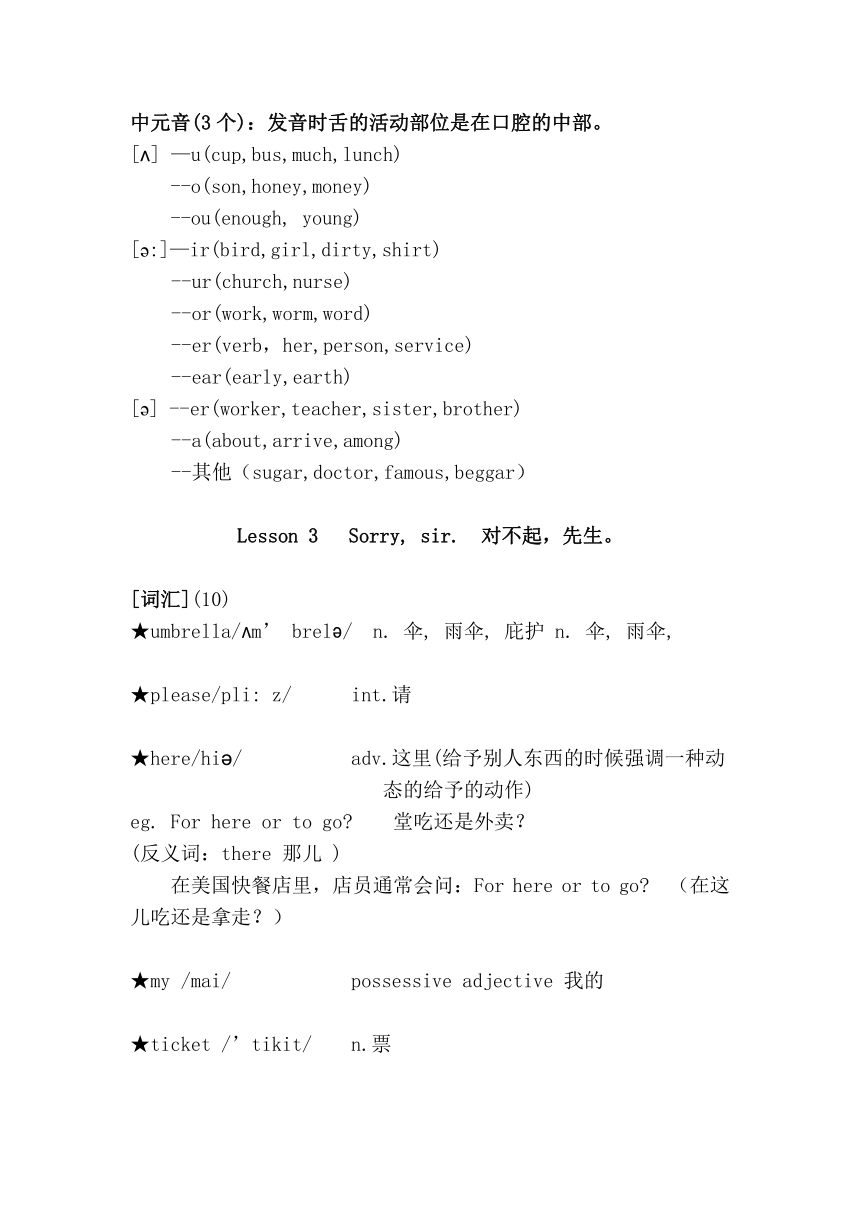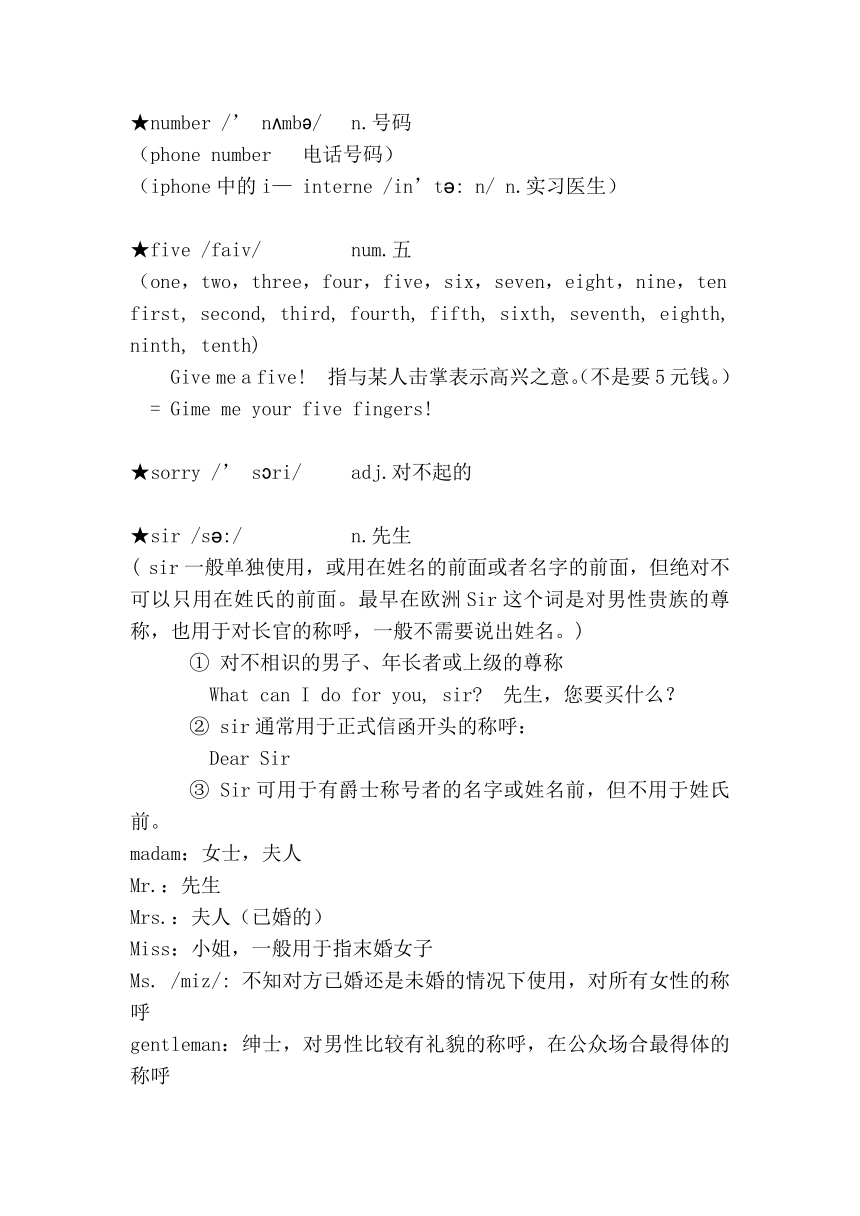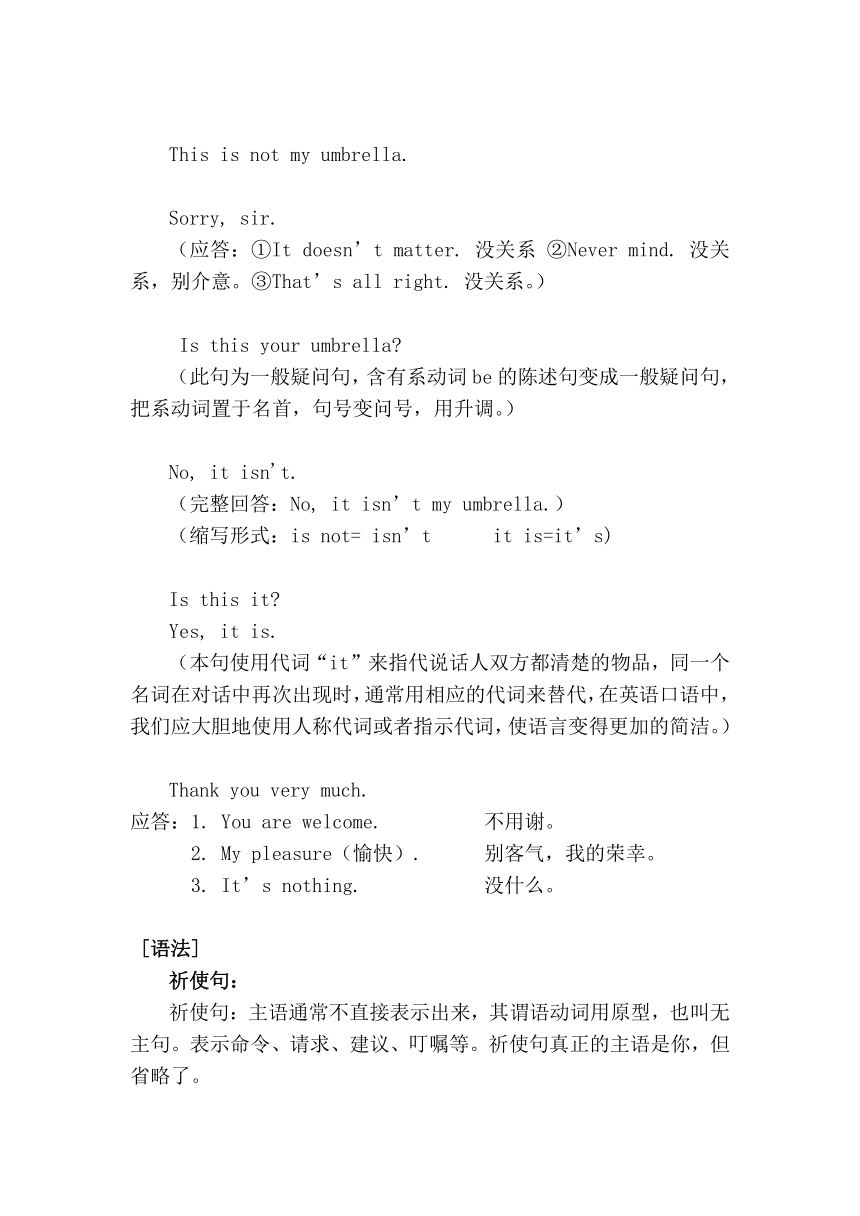新概念英语一册Lesson3-4 知识点讲义
文档属性
| 名称 | 新概念英语一册Lesson3-4 知识点讲义 |  | |
| 格式 | docx | ||
| 文件大小 | 32.5KB | ||
| 资源类型 | 教案 | ||
| 版本资源 | 新概念英语 | ||
| 科目 | 英语 | ||
| 更新时间 | 2024-02-07 14:59:15 | ||
图片预览




文档简介
中元音(3个):发音时舌的活动部位是在口腔的中部。
[ ] —u(cup,bus,much,lunch)
--o(son,honey,money)
--ou(enough, young)
[ :]—ir(bird,girl,dirty,shirt)
--ur(church,nurse)
--or(work,worm,word)
--er(verb,her,person,service)
--ear(early,earth)
[ ] --er(worker,teacher,sister,brother)
--a(about,arrive,among)
--其他(sugar,doctor,famous,beggar)
Lesson 3 Sorry, sir. 对不起,先生。
[词汇](10)
★umbrella/ m’ brel / n. 伞, 雨伞, 庇护 n. 伞, 雨伞,
★please/pli: z/ int.请
★here/hi / adv.这里(给予别人东西的时候强调一种动
态的给予的动作)
eg. For here or to go 堂吃还是外卖?
(反义词:there 那儿 )
在美国快餐店里,店员通常会问:For here or to go (在这儿吃还是拿走?)
★my /mai/ possessive adjective 我的
★ticket /’tikit/ n.票
★number /’ n mb / n.号码
(phone number 电话号码)
(iphone中的i— interne /in’t : n/ n.实习医生)
★five /faiv/ num.五
(one,two,three,four,five,six,seven,eight,nine,ten
first, second, third, fourth, fifth, sixth, seventh, eighth, ninth, tenth)
Give me a five! 指与某人击掌表示高兴之意。(不是要5元钱。)
= Gime me your five fingers!
★sorry /’ s ri/ adj.对不起的
★sir /s :/ n.先生
( sir一般单独使用,或用在姓名的前面或者名字的前面,但绝对不可以只用在姓氏的前面。最早在欧洲Sir这个词是对男性贵族的尊称,也用于对长官的称呼,一般不需要说出姓名。)
① 对不相识的男子、年长者或上级的尊称
What can I do for you, sir 先生,您要买什么?
② sir通常用于正式信函开头的称呼:
Dear Sir
③ Sir可用于有爵士称号者的名字或姓名前,但不用于姓氏前。
madam:女士,夫人
Mr.:先生
Mrs.:夫人(已婚的)
Miss:小姐,一般用于指末婚女子
Ms. /miz/: 不知对方已婚还是未婚的情况下使用,对所有女性的称呼
gentleman:绅士,对男性比较有礼貌的称呼,在公众场合最得体的称呼
lady:女士
male 男性 female 女性
man 男人 woman 妇女
(oh ,boy! oh,man! oh,my god!. 都是表示惊叹、惊讶、或惊恐的意思,正如中国人说:“我的妈呀”“我的天啊”一样.)
(Men’s room 男厕, Ladies’ room或Women’s room 女厕)
(powder room = bath room 洗手间)
(Where’s the john 厕所在哪里?)
cloakroom /’ kl ukru: m/ n.衣帽存放处、衣帽储藏间、衣帽间
(cloak 披风,斗篷)
[课文]
My coat and my umbrella please.
(全句应该是:Give me my coat and my umbrella please. 此句省略了动词give给, give sb. sth. 或give sth. to sb. 把某物给某人, sb.—somebody某人, sth.—something某物)
( 例:Coffee, please.)
Here is my ticket.
(这里的my也可以换为其他人称的形容词性物主代词。)
(本句是典型的倒装句。原句应是:My ticket is here. 用倒装的句式起强调作用,来表示说话的重点。)
Thank you, sir.
Number five.
Here's your umbrella and your coat.
(这句是经典的“就近原则”,常规句应是:Your umbrella and your coat are here. 但是写成倒装形态时,be动词发生了改变,由复数的are改为单数的is,因为倒装后与be动词离得最近的词是单数名词“umbrella”, 所以用is。 and是连词,表示“和”,连接两个并列成份,位置可以互换。)
This is not my umbrella.
Sorry, sir.
(应答:①It doesn’t matter. 没关系 ②Never mind. 没关系,别介意。③That’s all right. 没关系。)
Is this your umbrella
(此句为一般疑问句,含有系动词be的陈述句变成一般疑问句,把系动词置于名首,句号变问号,用升调。)
No, it isn't.
(完整回答:No, it isn’t my umbrella.)
(缩写形式:is not= isn’t it is=it’s)
Is this it
Yes, it is.
(本句使用代词“it”来指代说话人双方都清楚的物品,同一个名词在对话中再次出现时,通常用相应的代词来替代,在英语口语中,我们应大胆地使用人称代词或者指示代词,使语言变得更加的简洁。)
Thank you very much.
应答:1. You are welcome. 不用谢。
2. My pleasure(愉快). 别客气,我的荣幸。
3. It’s nothing. 没什么。
[语法]
祈使句:
祈使句:主语通常不直接表示出来,其谓语动词用原型,也叫无主句。表示命令、请求、建议、叮嘱等。祈使句真正的主语是你,但省略了。
(Give me) My umbrella and my coat please. 省略了动词和间接宾语的祈使句。
Keep off the grass! 请勿践踏草地!
Help yourself! 请自己动手!
某些祈使动词可以后跟and和另一个祈使动词,而不是后跟带to的动词不定式结构。
Come and see this goldfish.
Go and buy yourself a new pair of shoes.
去给自己买双新鞋吧。
Wait and see. 等着瞧吧。
倒装句:
here is 是简单的倒装句,be 动词放在 here 的后面,这个句式就可以成为简单的倒装句式。
My ticket is here. 我的票在这。
Here is my ticket. / Here's my ticket
Lesson 4 Is this your… 这是你的…吗?
[词汇](5)
★suit /sju: t/ n.一套衣服(指同一种料子做的整套衣服)
(suit指“一套衣服”时,多指男西装,可用词组a suit of clothes表达,suite/swi:t/ 一套家具、房间、乐曲)
(a suit 一套西装/ a bathing suit一套泳装)
★school /sku: l/ n.学校
(小学:primary /’praim ri/基本的 school
中学:middle school
高中:high school
大学:university)
★teacher /’ ti: t / n.老师(teach 教学)
(汉语中常把姓氏直接加在“老师”之前,表示称为,如李老师、王老师等,英语中却不能说:teacher Li, teacher Wang, 而要说Mr. Li, Miss Wang.)
★son /s n/ n.儿子(sun 太阳)
(son in law 女婿 )
(Like father, like son. 有其父,必有其子。)
daughter /’ d : t / n.女儿
(daughter in law 媳妇)great-grandfather / great-grandmother
great-grandson / great-granddaughter
Grandmother / grandfather ( grandma / grandpa)
father / mother(daddy, mummy, dad , mum )
Uncle / aunt
nephew / niece
cousin (first cousin 父母的亲兄弟姐妹的孩子
second cousin 父母的表兄弟、表姐妹的孩子)
brother / sister (younger / elder)
son / daughter (love children)(私生子)
step-mother / father / sister / brother / son / daughter
mother / father/ sister / brother / -in-law
[课文]
Is this your pen No, it isn’t. It isn’t my pen. It’s your pen.
Is this your pencil No, it isn’t. It isn’t my pencil. It’s your pencil.
Is this your book No, it isn’t. It isn’t my book. It’s your book.
Is this your watch No, it isn’t. It isn’t my watch. It’s your watch.
Is this your coat No, it isn’t. It isn’t my coat. It’s your coat.
Is this your dress No, it isn’t. It isn’t my dress. It’s your dress.
Is this your skirt No, it isn’t. It isn’t my skirt. It’s your skirt.
Is this your shirt No, it isn’t. It isn’t my shirt. It’s your shirt.
Is this your car No, it isn’t. It isn’t my car. It’s your car.
Is this your house No, it isn’t. It isn’t my house. It’s your house.
Is this your suit No, it isn’t. It isn’t my suit. It’s your suit.
Is this your school No, it isn’t. It isn’t my school. It’s your school.
Is this your teacher No, it isn’t. It isn’t my teacher. It’s your teacher.
Is this your son No, it isn’t. It isn’t my son. It’s your son.
Is this your daughter No, it isn’t. It isn’t my daughter. It’s your daughter.
总结:
肯定句: This is my umbrella.
否定句: This is not my umbrella.
(要想变否定,is/are后加not.)
一般疑问句: Is this your umbrella?
(要想变疑问,is/are放句首。)
肯定回答: Yes, it is.
否定回答: No, it isn’t.
be动词肯定缩略形式:
She is = she’s he is = he’s it is = it’s
we are = we’re I am = I’m you are = you’re
they are = they’re here is = here’s here are = here’re
be动词否定缩略形式:
is not = isn’t are not = aren’t am not没有缩略形式
[ ] —u(cup,bus,much,lunch)
--o(son,honey,money)
--ou(enough, young)
[ :]—ir(bird,girl,dirty,shirt)
--ur(church,nurse)
--or(work,worm,word)
--er(verb,her,person,service)
--ear(early,earth)
[ ] --er(worker,teacher,sister,brother)
--a(about,arrive,among)
--其他(sugar,doctor,famous,beggar)
Lesson 3 Sorry, sir. 对不起,先生。
[词汇](10)
★umbrella/ m’ brel / n. 伞, 雨伞, 庇护 n. 伞, 雨伞,
★please/pli: z/ int.请
★here/hi / adv.这里(给予别人东西的时候强调一种动
态的给予的动作)
eg. For here or to go 堂吃还是外卖?
(反义词:there 那儿 )
在美国快餐店里,店员通常会问:For here or to go (在这儿吃还是拿走?)
★my /mai/ possessive adjective 我的
★ticket /’tikit/ n.票
★number /’ n mb / n.号码
(phone number 电话号码)
(iphone中的i— interne /in’t : n/ n.实习医生)
★five /faiv/ num.五
(one,two,three,four,five,six,seven,eight,nine,ten
first, second, third, fourth, fifth, sixth, seventh, eighth, ninth, tenth)
Give me a five! 指与某人击掌表示高兴之意。(不是要5元钱。)
= Gime me your five fingers!
★sorry /’ s ri/ adj.对不起的
★sir /s :/ n.先生
( sir一般单独使用,或用在姓名的前面或者名字的前面,但绝对不可以只用在姓氏的前面。最早在欧洲Sir这个词是对男性贵族的尊称,也用于对长官的称呼,一般不需要说出姓名。)
① 对不相识的男子、年长者或上级的尊称
What can I do for you, sir 先生,您要买什么?
② sir通常用于正式信函开头的称呼:
Dear Sir
③ Sir可用于有爵士称号者的名字或姓名前,但不用于姓氏前。
madam:女士,夫人
Mr.:先生
Mrs.:夫人(已婚的)
Miss:小姐,一般用于指末婚女子
Ms. /miz/: 不知对方已婚还是未婚的情况下使用,对所有女性的称呼
gentleman:绅士,对男性比较有礼貌的称呼,在公众场合最得体的称呼
lady:女士
male 男性 female 女性
man 男人 woman 妇女
(oh ,boy! oh,man! oh,my god!. 都是表示惊叹、惊讶、或惊恐的意思,正如中国人说:“我的妈呀”“我的天啊”一样.)
(Men’s room 男厕, Ladies’ room或Women’s room 女厕)
(powder room = bath room 洗手间)
(Where’s the john 厕所在哪里?)
cloakroom /’ kl ukru: m/ n.衣帽存放处、衣帽储藏间、衣帽间
(cloak 披风,斗篷)
[课文]
My coat and my umbrella please.
(全句应该是:Give me my coat and my umbrella please. 此句省略了动词give给, give sb. sth. 或give sth. to sb. 把某物给某人, sb.—somebody某人, sth.—something某物)
( 例:Coffee, please.)
Here is my ticket.
(这里的my也可以换为其他人称的形容词性物主代词。)
(本句是典型的倒装句。原句应是:My ticket is here. 用倒装的句式起强调作用,来表示说话的重点。)
Thank you, sir.
Number five.
Here's your umbrella and your coat.
(这句是经典的“就近原则”,常规句应是:Your umbrella and your coat are here. 但是写成倒装形态时,be动词发生了改变,由复数的are改为单数的is,因为倒装后与be动词离得最近的词是单数名词“umbrella”, 所以用is。 and是连词,表示“和”,连接两个并列成份,位置可以互换。)
This is not my umbrella.
Sorry, sir.
(应答:①It doesn’t matter. 没关系 ②Never mind. 没关系,别介意。③That’s all right. 没关系。)
Is this your umbrella
(此句为一般疑问句,含有系动词be的陈述句变成一般疑问句,把系动词置于名首,句号变问号,用升调。)
No, it isn't.
(完整回答:No, it isn’t my umbrella.)
(缩写形式:is not= isn’t it is=it’s)
Is this it
Yes, it is.
(本句使用代词“it”来指代说话人双方都清楚的物品,同一个名词在对话中再次出现时,通常用相应的代词来替代,在英语口语中,我们应大胆地使用人称代词或者指示代词,使语言变得更加的简洁。)
Thank you very much.
应答:1. You are welcome. 不用谢。
2. My pleasure(愉快). 别客气,我的荣幸。
3. It’s nothing. 没什么。
[语法]
祈使句:
祈使句:主语通常不直接表示出来,其谓语动词用原型,也叫无主句。表示命令、请求、建议、叮嘱等。祈使句真正的主语是你,但省略了。
(Give me) My umbrella and my coat please. 省略了动词和间接宾语的祈使句。
Keep off the grass! 请勿践踏草地!
Help yourself! 请自己动手!
某些祈使动词可以后跟and和另一个祈使动词,而不是后跟带to的动词不定式结构。
Come and see this goldfish.
Go and buy yourself a new pair of shoes.
去给自己买双新鞋吧。
Wait and see. 等着瞧吧。
倒装句:
here is 是简单的倒装句,be 动词放在 here 的后面,这个句式就可以成为简单的倒装句式。
My ticket is here. 我的票在这。
Here is my ticket. / Here's my ticket
Lesson 4 Is this your… 这是你的…吗?
[词汇](5)
★suit /sju: t/ n.一套衣服(指同一种料子做的整套衣服)
(suit指“一套衣服”时,多指男西装,可用词组a suit of clothes表达,suite/swi:t/ 一套家具、房间、乐曲)
(a suit 一套西装/ a bathing suit一套泳装)
★school /sku: l/ n.学校
(小学:primary /’praim ri/基本的 school
中学:middle school
高中:high school
大学:university)
★teacher /’ ti: t / n.老师(teach 教学)
(汉语中常把姓氏直接加在“老师”之前,表示称为,如李老师、王老师等,英语中却不能说:teacher Li, teacher Wang, 而要说Mr. Li, Miss Wang.)
★son /s n/ n.儿子(sun 太阳)
(son in law 女婿 )
(Like father, like son. 有其父,必有其子。)
daughter /’ d : t / n.女儿
(daughter in law 媳妇)great-grandfather / great-grandmother
great-grandson / great-granddaughter
Grandmother / grandfather ( grandma / grandpa)
father / mother(daddy, mummy, dad , mum )
Uncle / aunt
nephew / niece
cousin (first cousin 父母的亲兄弟姐妹的孩子
second cousin 父母的表兄弟、表姐妹的孩子)
brother / sister (younger / elder)
son / daughter (love children)(私生子)
step-mother / father / sister / brother / son / daughter
mother / father/ sister / brother / -in-law
[课文]
Is this your pen No, it isn’t. It isn’t my pen. It’s your pen.
Is this your pencil No, it isn’t. It isn’t my pencil. It’s your pencil.
Is this your book No, it isn’t. It isn’t my book. It’s your book.
Is this your watch No, it isn’t. It isn’t my watch. It’s your watch.
Is this your coat No, it isn’t. It isn’t my coat. It’s your coat.
Is this your dress No, it isn’t. It isn’t my dress. It’s your dress.
Is this your skirt No, it isn’t. It isn’t my skirt. It’s your skirt.
Is this your shirt No, it isn’t. It isn’t my shirt. It’s your shirt.
Is this your car No, it isn’t. It isn’t my car. It’s your car.
Is this your house No, it isn’t. It isn’t my house. It’s your house.
Is this your suit No, it isn’t. It isn’t my suit. It’s your suit.
Is this your school No, it isn’t. It isn’t my school. It’s your school.
Is this your teacher No, it isn’t. It isn’t my teacher. It’s your teacher.
Is this your son No, it isn’t. It isn’t my son. It’s your son.
Is this your daughter No, it isn’t. It isn’t my daughter. It’s your daughter.
总结:
肯定句: This is my umbrella.
否定句: This is not my umbrella.
(要想变否定,is/are后加not.)
一般疑问句: Is this your umbrella?
(要想变疑问,is/are放句首。)
肯定回答: Yes, it is.
否定回答: No, it isn’t.
be动词肯定缩略形式:
She is = she’s he is = he’s it is = it’s
we are = we’re I am = I’m you are = you’re
they are = they’re here is = here’s here are = here’re
be动词否定缩略形式:
is not = isn’t are not = aren’t am not没有缩略形式
同课章节目录
